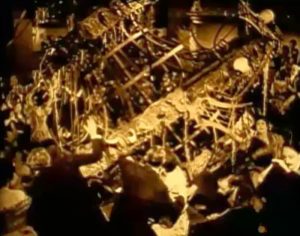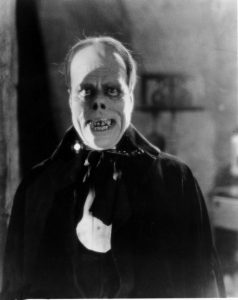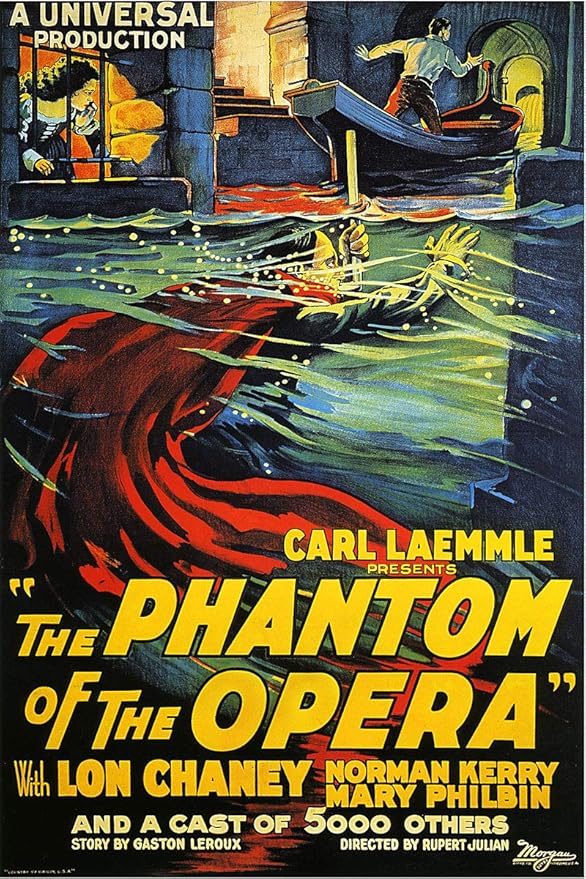A malformed, masked entity lurks in the shadows of a Parisian Opera house. His presence had only haunted the house until an aspiring opera singer, Christine Daaé, stepped onto the stage. However, then the so-called “Phantom” develops a desire to help Christine in her career and become the lead performer–but at what cost?
This year marks the 100th anniversary of the 1925 film The Phantom of the Opera. The story of The Phantom has been told and retold since it first hit the public in 1910 when a French author, Gaston Leroux, published his first novel Le Fantôme de l’opéra. Although there are different variations of the story, there’s a pretty solid base structure for how the story is told. A ghost is rumored to haunt an Opera house in Paris after a man, Joseph Buquet, is found hanging with no rope. A young and newly emerging singer, Christine Daae, begins her career when the lead singer at the Opera house, Carlotta, becomes ill. The Phantom develops an interest in Christine and vows to help her excel as a vocalist. He attempts to do this by writing a letter to the Opera house, threatening them if they don’t cast Christine as the lead in Faust. They don’t follow through with his orders: Carlotta ends up physically unable to sing, the iconic chandelier falls killing a spectator.
(the chandelier falling)Christine is then abducted by the Phantom, who, at this point, we know isn’t some divine or otherworldly being, but rather a man named Erik. He was exiled from the French government for being “criminally insane” and cast into the depths of the Opera house. Erik ends up falling in love with Christine, but her lover, Rauol, and his mask being removed gets in the way of his plans. He keeps Christine in his lair as he wants to be with her forever, but Rauol fights to free her. Eventually Rauol and Christine end up together and The Phantom is back to his fated destiny of living his life in solitude.
This plot has been delivered through book, multiple film renditions, and has been the longest-running Broadway show ever. Each rendition of the story holds a uniqueness that can be appreciated, but they’re so different they almost become incomparable. I say “almost” because the 1925 rendition of the film, the first cinematic depiction, cannot be topped. The film’s genre is listed as “horror” and in terms of “horrifying”, it may not have you throwing your popcorn around the theatre or cause you to sleep with a night light on, but there’s undoubtedly an eeriness about the film that doesn’t go unnoticed. The intersection of it being a black and white film, as well as a silent one, creates a very specific vibe that we tend to lose in films now. It adds an element of mystery and wonder, and what’s more horrifying than the unknown? The artistry in the film is shown through gestures big and small. When the giant chandelier crashes down on the spectators during the performance, we can’t hear any screams, but we can feel the instant fear and panic ensues on the audience. Before The Phantom is revealed, his silhouette is cast on the walls through shadow. His being is merely a whisper through the town, hardly anyone has seen him and lived to tell the tale. This takes me back to my point before, utilizing what we can’t see can be more horrifying than what we can see.
The film industry has leaned away from producing art on this specific level. With an increase in technology and abilities, we now have superb color, sound, and even special effects like CGI. I am not saying the films created now aren’t artistic, they’ve just majorly shifted in aesthetic value. One of the most well-known aspects of The Phantom of the Opera is the soundtrack produced by the esteemed Andrew Lloyd Webber, which is not part of the 1925 film. This does not mean the film lacks significance, though, as it remains a classic in the silent film industry. The lack of color and music shouldn’t be a problem in this movie’s composition as it causes you to feel entranced by what’s actually happening in the plot. Lo Chaney, the actor who plays The Phantom, is known for his acting and also his impressive ability to do special effects makeup. He is even known as “The Man of a Thousand Faces.” He was before his time in how he constructed his Phantom face, it was a major development for this specific film.

(Erik without his mask)
Before releasing the film to the public, they decided to keep his face a secret until it was in theatres to add an extra level of mystery. It was so shocking that audience members were reported to faint upon first viewing it. This seems like an absurd circumstance now because of the many, more unquestionably horrifying creatures we’ve seen in the film industry, but we also have to recognize the time and place. Nonetheless, it is very much still art.
The film can be used, not only for aesthetic value or historical film prevalence, but there’s also an underlying theme in the midst of it all. Erik, at the end of the day, was just a man who suffered from a mental illness and a face deformity. He was a criminal and definitely made some questionable decisions, but his situation almost makes you feel bad for him. He was cast out of society because of his circumstances, but it was the cruelty and hatred of humankind that made him The Phantom. How couldn’t we expect deviant behavior from him when society had turned him into a monster? It’s unjustifiable to kidnap anyone or murder them in cold blood, but I’m not sure what other behavior you would expect to see from someone who’s been living underground for the majority of his life. Someone who has been turned into a whisper in the night, but not under his own accord. Someone who has been stripped of their personhood. All of the film conflicts could have been prevented if Erik had been approached in a humane way. Next time you want to cast someone out or label them as The Phantom, think about what things make them different from you and think about what things make you different from them. This shouldn’t create a divide between you, but rather help you acknowledge your differences and how you can exist together despite them.


Outstanding and very well written. I will be watching the 1925 film tonight! Thank you.